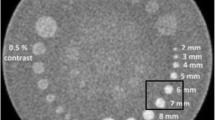Abstract
Practical simulations of low-dose CT images have a possibility of being helpful means for optimization of the CT exposure dose. Because current methods reported by several researchers are limited to specific vendor platforms and generally rely on raw sinogram data that are difficult to access, we have developed a new computerized scheme for producing simulated low-dose CT images from real high-dose images without use of raw sinogram data or of a particular phantom. Our computerized scheme for low-dose CT simulation was based on the addition of a simulated noise image to a real high-dose CT image reconstructed by the filtered back-projection algorithm. First, a sinogram was generated from the forward projection of a high-dose CT image. Then, an additional noise sinogram resulting from use of a reduced exposure dose was estimated from a predetermined noise model. Finally, a noise CT image was reconstructed with a predetermined filter and was added to the real high-dose CT image to create a simulated low-dose CT image. The noise power spectrum and modulation transfer function of the simulated low-dose images were very close to those of the real low-dose images. In order to confirm the feasibility of our method, we applied this method to clinical cases which were examined with the high dose initially and then followed with a low-dose CT. In conclusion, our proposed method could simulate the low-dose CT images from their real high-dose images with sufficient accuracy and could be used for determining the optimal dose setting for various clinical CT examinations.









Similar content being viewed by others
References
What are the radiation risks from CT? US Food and Drug Administration. 2009. http://www.fda.gov/Radiation-EmittingProducts/RadiationEmittingProductsandProceedures/MedicalImaging/MedicalX-Rays/ucm115329.htm.
Furlow B. Radiation dose in computed tomography. Radiol Technol. 2010;81(5):437–50.
Frush DP, Slack CC, Hollingsworth CL, et al. Computer-simulated radiation dose reduction for abdominal multidetector CT of pediatric patients. AJR. 2002;179:1107–13.
Tack D, Maertelaer VD, Petit W, et al. Multi-detector row CT pulmonary angiography: comparison of standard-dose and simulated low-dose techniques. Radiology. 2005;236(1):318–25.
Žabić S, Wang Q, Morton T, et al. A low dose simulation tool for CT systems with energy integrating detectors. Med Phys. 2013;40(3):031102 (14 p).
Britten AJ, Crotty M, Kiremidjlan H, et al. The addition of computer simulated noise to investigate radiation dose and image quality in images with spatial correlation of statistical noise: an example application to X-ray CT of the brain. Br J Radiol. 2004;77:323–8.
Li X, Samei E, DeLong DM, et al. Towards assessing the diagnostic influence of dose reduction on the detection of small lung nodules. Acad Radiol. 2009;16(7):872–80.
Kim C, Kim J. Realistic simulation of reduced-dose CT using DICOM CT images. Med Phys. 2014;41(1):011901 (16 p).
Hsieh J. Computed tomography: principles, design, artifacts, and recent advances. Washington: SPIE Press; 2009. p. 235–8.
Siewerdsen JH, Cunningham IA, Jaffray DA. A framework for noise-power spectrum analysis of multidimensional images. Med Phys. 2002;29(11):2655–71.
Takenaga T, Katsuragawa S, Goto M. Modulation transfer function measurement of CT images by use of a circular edge method with a logistic curve-fitting technique. RPT. 2015;8:53–9.
Thibault JB, Sauer KD, Bouman CB, et al. A three-dimensional statistical approach to improved image quality for multislice helical CT. Med Phys. 2007;34(111):4526–44.
Acknowledgments
This work was supported by JSPS KAKENHI Grant Numbers 22611014 and 15K09898.
Author information
Authors and Affiliations
Corresponding author
Ethics declarations
Conflict of interest
The authors declare that they have no conflict of interest.
About this article
Cite this article
Takenaga, T., Katsuragawa, S., Goto, M. et al. A computer simulation method for low-dose CT images by use of real high-dose images: a phantom study. Radiol Phys Technol 9, 44–52 (2016). https://doi.org/10.1007/s12194-015-0332-3
Received:
Revised:
Accepted:
Published:
Issue Date:
DOI: https://doi.org/10.1007/s12194-015-0332-3




